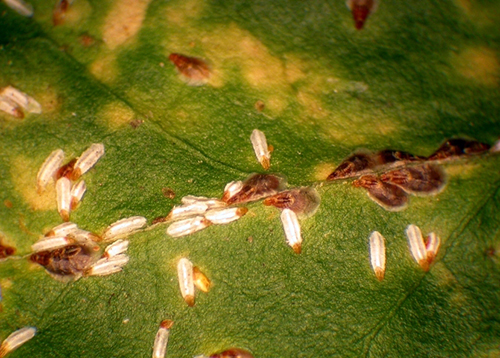Integrated Pest Management
Euonymus Scale
Unaspis euonymi
Pest Description
- males: 1/16 inch; white, oysterlike hard scales
- females: longer and wider than males; mottled brown
- immatures: crawlers (mobile stage) 3/64 inch; yellow orange; no wings
- immatures: nymphs (sessile stage) resemble adults, but are smaller
Host Plants, Diet & Damage
- Euonymus, Camellia, boxwood, bittersweet, Daphne, Eugenia, ivy, Hibiscus, holly, jasmine, privet, honeysuckle, olive, Paxistima, Pachysandra, Solanum and Prunus
- feed on leaves (mostly on the undersides) and stems
- males are typically found on the undersides of leaves; females mostly found on stems/petioles
- create yellow-white spots on leaves
- scales covering stems appear bumpy, corky or frosted
- feeding can cause thinning, leaf drop and plant death
- damage is often worse when plants are located near buildings/walls/etc.
Biology, Life Cycle & Damaging Life Stage
- overwinter as fertilized females or male pre-pupae
- males molt into flying insects and mate with females
- eggs laid in early spring (May to June) under the female
- crawlers present late-May to June and July to October
- crawlers disperse via crawling or wind currents
- there are two generations per year, but life stages overlap
- nymphs and adults are the damaging stages
IPM Recommendations
- Keep trees healthy.
- Monitor scale populations on host plants (e.g., Euonymus).
- Non-synchronized life cycle makes crawler control with foliar-applied insecticides difficult.
- Apply a systemic dinotefuran soil drench, granules or bark band in May. Imidacloprid is ineffective against hard scales.




